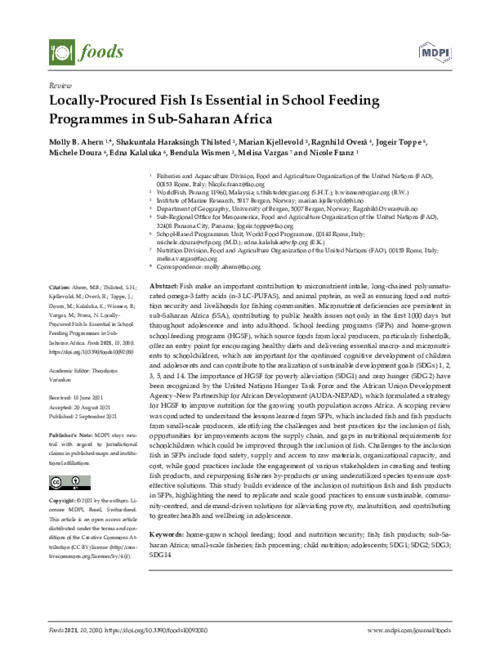Locally-procured Fish is Essential in School Feeding Programmes in Sub-Saharan Africa
Abstract
Fish make an important contribution to micronutrient intake, long-chained polyunsaturated omega-3 fatty acids (n-3 LC-PUFAS), and animal protein, as well as ensuring food and nutrition security and livelihoods for fishing communities. Micronutrient deficiencies are persistent in sub-Saharan Africa (SSA), contributing to public health issues not only in the first 1000 days but throughout adolescence and into adulthood. School feeding programs (SFPs) and home-grown school feeding programs (HGSF), which source foods from local producers, particularly fisherfolk, offer an entry point for encouraging healthy diets and delivering essential macro- and micronutrients to schoolchildren, which are important for the continued cognitive development of children and adolescents and can contribute to the realization of sustainable development goals (SDGs) 1, 2, 3, 5, and 14. The importance of HGSF for poverty alleviation (SDG1) and zero hunger (SDG 2) have been recognized by the United Nations Hunger Task Force and the African Union Development Agency–New Partnership for African Development (AUDA-NEPAD), which formulated a strategy for HGSF to improve nutrition for the growing youth population across Africa. A scoping review was conducted to understand the lessons learned from SFPs, which included fish and fish products from small-scale producers, identifying the challenges and best practices for the inclusion of fish, opportunities for improvements across the supply chain, and gaps in nutritional requirements for schoolchildren which could be improved through the inclusion of fish. Challenges to the inclusion fish in SFPs include food safety, supply and access to raw materials, organizational capacity, and cost, while good practices include the engagement of various stakeholders in creating and testing fish products, and repurposing fisheries by-products or using underutilized species to ensure cost-effective solutions. This study builds evidence of the inclusion of nutritious fish and fish products in SFPs, highlighting the need to replicate and scale good practices to ensure sustainable, community-centred, and demand-driven solutions for alleviating poverty, malnutrition, and contributing to greater health and wellbeing in adolescence

